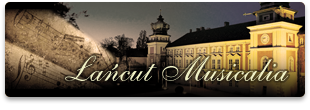You may see here
Łańcut Castle is one of the most beautiful aristocratic residences in Poland, famous for its excellent interiors and extraordinarily interesting collection of horse-drawn carriages. The palace complex is surrounded by an old and picturesque park in the English style filled with pavilions and farm buildings, all part of the former the daily life of the castle.
Castle
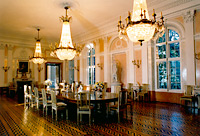
The Castle interiors are considered the most beautiful in Poland. The oldest preserved rooms are: Great Vestibule, Room under the Wooden Ceiling and Zodiac Room. They date back to the 40’s of the 17th century but unfortunately none of them remained in its original form.
There is a number of rooms which were created in the 18th century. Chronologically the oldest were decorated at the beginning of the 80’s by the Italian artist Vincenzo Brenne. They include: Brenne Apartment on the ground floor, Pompeian Room on the second floor and Chinese Apartment on the first floor. The last one contains historic polychromy hidden under later decorations.
Several rooms designed by Szymon Bogumił Zug come from the 2nd half of the 18th century: Turkish Apartment, Columned Salon and designed together with Jan Christian Kamsetzer: Princess’ Bedroom, Boucher Salon. Rococo Salon and Sculpture Gallery also come from this period.
The most representative rooms were created in 1800 on the first floor of the west wing on the basis of Krystian Piotr Aigner’s designs. They include: classicist Ball Room and Great Dining Room.
At the turn of the 19th and the 20th century numerous interesting interiors were arranged and majority of them remained in its original form. The most impressive include: Library, Corner Salon, Dining Room over the Gate and a lot of bathrooms.
The interiors hold numerous works of art which come from the old Łańcut collections and from other museums. The oldest exhibits create a part of collection made by Princess Lubomirska and they were brought to Łańcut in the 2nd half of the 18th century. The exhibits were used both as decorations and as everyday use objects. Some of the most valuable exhibits from this collection may be admired in the Gallery of Ancient Art in the National Museum in Warsaw.
Successive owners from the Potocki family extended the collection by adding new exhibits. Today in Łańcut one may see rich and various collections of paintings and graphics, furniture, musical instruments, silver, porcelain, glass, fabric and a magnificent book collection.
see more »Stables and Couch House
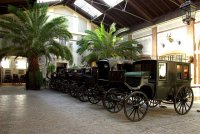
Two impressive buildings of Neo-Baroque Stables and modern yet with classicist elements Carriage House are a part of the Potocki’s Łańcut residence. They were raised at the turn of the 19th and the 20th century on the basis of the design made by the French architect Armand Bauque and they were surrounded with a specially created ‘Park at the Stables’. Decorating and furnishing of the Grooming Room and the Harnessing Hall was conducted by the company from Vienna R. Ph. Waagner.
Stables contain the original part for mounting horses, the Grooming Room and the Hall where one may see horse-drawn carriages from the Museum Carriage Collection. Museum in Łańcut holds two separate collections of horse-drawn carriages: historical one connected with the Potocki family which includes 55 carriages and a museum one – gathered after World War II and still open – which contains about 80 carriages.
Łańcut Carriage House has an enormous Harnessing Hall with a glass roof and two Carriage Houses – Yellow and Black – on both sides of the Hall and the Grooming Room. The walls of the Hall are decorated with exotic trophies brought in 1924 from the safari by the last owner of the Castle and some European trophies. One may also find here carriages from the Museum Collection. The Grooming Room holds horse collars and carriage harnesses made in Paris by Hermes &Duprey and in Vienna by Schleuchter &Nideltz.
The most valuable mobile objects gathered in the Castle Carriage House constitute a priceless collection of horse-drawn carriages owned by the Potocki family. These luxurious carriages of different types and purposes were made by the most famous companies in Vienna, Paris or London such as Marius, Lohner, Labourdette or Rotchild. They are located in two Carriage Houses – carriages used for galas in one and carriages used everyday in the other. These carriages – although they are over 100 years old – remain in a very good condition and are still in their original forms owing to an excellent preservation. It is the only Carriage House in the world where apart from the historical residence one may & such rich and well preserved collection of carriages.
see more »Orthodox Art
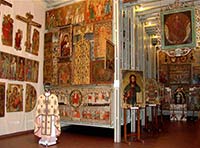
Creating a collection of Orthodox Art in Łańcut was caused by the necessity of preserving priceless elements of culture. They were prone to destruction because of the displacing of the Ukrainian people from the south – eastern part Poland in 1945 and 1947. Many years of conscious destruction of historic monuments of sacral art led to ruin of about 330 out of 650 orthodox churches which existed in this part of historical diocese of Przemyśl. Cumulation of damages was prevented by the action organized by museum workers which focused on preserving ‘the unwanted historic remembrances’ mostly paintings, book collections and artistic craft. This action included creating of The Warehouse of Mobile Exhibits in Łańcut which was later changed into the Section of Orthodox Art of the Castle Museum in Łańcut. Objects from the orthodox churches which were left unattended were systematically brought to the Museum.
At the beginning it was in the warehouses and later in properly adapted wing of the old Stables where there was a room for over 1000 icons (15th – 20th century), artistic craft and over 300 volumes of textures. The finest piece in this collection is the carefully renovated Apostle from the Fedorow Printing - House in Lvov from 1574. At present it is the largest collection of the Ukrainian Orthodox Art in Poland. The exhibition is under constant conservatory supervision. It was enriched by adding museum exhibits and it is accessible to visitors. Some of the Orthodox Art exhibits were given back to orthodox churches where they may also be admired.
see more »Orchid House
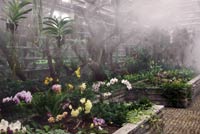
The Orchid House consists of an exhibition, a back part divided into three climatic zones and a summer cafe.
The Orchid House is equipped with advanced device which serves to keep optimal condition for the cultivation of this demanding group of plants.
In the exhibition many species and genus of orchids are presented. This is where the most effective, blooming plants are brought. The remaining part of the year they are cultivated in one of the three greenhouses in the back part, under proper conditions for the origin climatic zone. In the exhibition we can see orchids growing in the ground, litophytes (growing on rocks) as well as epiphytes (growing on tree branches).
Here we can see contemporary cross-breeds cultivated by men, botanic orchids created by nature without the invasion of men, as well as historic species and genus of orchids from the Potocki’s collection before war, but also those mentioned in the famous study „Reichenbachia” from the 19th century, which is kept in save custody of the castle library in Łańcut.
Among the corollary plants we can find tree branches with epiphytic orchids, that represent a very big group of plants, which is very characteristic for tropical and subtropical areas. The specific structure of their roots is capable to soak up water from the atmosphere.
Our collection is systematically improved by adding new orchid species.
see more »History of the City and Region with overview of the 10th Mounted Rifle Regiment
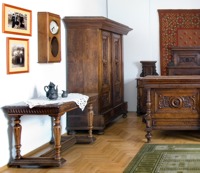
Section of History of the City and Region was created in 1979. It was connected with a takeover of the building of Synagogue together with ethnographic collections. That process begun creating new expositions, previously named ‘Regional Section’. Deriving from the former Łańcut county, collections were enriched by additional exhibits so that three permanent expositions were created (middle-class, ethnographic and regimental).
In 1984 Sgt Konstanty Bieniasz was the initiator of creating the 10th Mounted Rifle Regiment Exhibition. The collections of remembrances belonged to the soldier deriving from Łańcut, firstly were presented on temporary exhibition but finally became a base for creation a permanent exposition. Farther gathering of exhibits mostly from former soldiers of the 10th Mounted Rifle Regiment allowed for the creation of a large collection illustrating the history of this magnificent unit. In the collection one may find both the objects from the World War II and from the period between the wars. The collection includes documents, photographs, uniforms, medals and orders.
In 1996 the set was enlarged by another part of collection directly connected to history of Łańcut. Presented objects dating from the turn of the 19th and the 20th century are a valuable source of cognition of social and material culture of society of that time. Both middle-class and ethnographic collection constitute of everyday use objects including clothes, furniture and other elements of furnishings. Exhibited sets of bedroom and study furniture with additional interior of hairdresser’s create a picture showing life of intelligentsia of Łancut. A collection of technical devices and other necessities present standard of living of inhabitants those days. There is also a large collection of sculpture made by local folk artists that shows the cultural development of the Łańcut region. In this part of the collection there are the guild privileges from the years 1564-1728, two village-mayor books from the 17th century, a set of hand written text copies of city privileges from the 18th century, old postcards and photographs and a number of private documents affixed with seals of Łańcut institutions.
see more »The Library
The Castle Library is a good example of an ancestral baronial library which was preserved almost untouched. It was built in the late 18th century for the then current owner of Łańcut Izabela Lubomirska of the Czartoryski family (1736-1816). Storeyed building of the Library was designed by Piotr Aigner. The Library owns its present look to two architects – Armand Bauque and Albert Pio who renovated it in the years 1899-1903. They created a high standard place in style that referred to the Late Victorian Era.
The interior of the Library is furnished with comfortable English furniture coming from the turn of the 19th and the 20th century. Bookcases hold a vast collection of books belonging to the successive heirs of Łańcut – the Potocki family. The collection contains over 22 thousand volumes. They are divided into seven sections: literature and magazines from the 19th and the beginning of the 20th century, out-of-print books, old maps, graphics, modern manuscripts and documents concerning music.
Among the rarities of the collection one may find: first prints of Karol Manneken’s Formulae epistolarum from 1491, Statuta Sigismundi Primi Poloniae Regis printed by Hieronim Vietor in 1524 in Cracow, Basel edition of Marcin Kromer’s Chronicle from 1555, Wilhelm and Jan Bleau’s collection of maps Orbis terrarum from the years 1640-1655. Łukasz Kranach’s drawings and Daniel Chodowiecki’s etchings are also of great value. Among old maps and plans special attention should be paid to Rizzi Zannoni’s La Pologne from 1772. Other unique objects include preserved certificates of nobility and diplomas of the Order of the Golden Fleece given to the owners of the Castle by the Emperor Francis Joseph.
The fact that the owners of the Castle were music lovers is proved by the preserved collection of over 1500 documents concerning music (containing about 30% of musical manuscripts). These documents include: autographs of scores of the buffo opera, comedie dell’arte, Giovanni Battista Cimadoro’s, Paisiello’s, Mozart’s, Bernardini di Capua’s or Gioacchino Rossini’s.
In 1998 the collection of the Castle Library was included into the National Library Collection. Apart from the Castle Library there is also a Museum Library which was established in 1958. It holds the written texts concerning history, art and culture, museum studies, preservation of historic monuments.
The historic and reference book collection is accessible to visitors in the reading room from Monday to Friday, 8.00 a.m. to 16.00 p.m.
Park
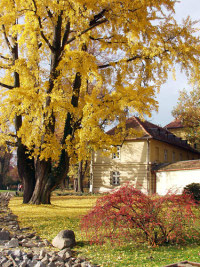
The historic Park in Łańcut dates back to the beginnings of the 18th and the 19th century when Stanisław Lubomirski, the great crown marshal, and his wife Izabela of the Czartoryski family became the owners of Łańcut. Later changes in the garden arrangements occurred in the late 19th century when Roman and Elżbieta Potocki renovated the Castle and took care of its proper surroundings. During intensive gardening works, which lasted 14 years, the composition of the park was fundamentally changed. Distinguished specialists even from foreign countries participated in redecorating works. At that time the park was enlarged twice and a vast area of land was enclosed from the east side. Such garden arrangements with minor improvements were maintained till 1944 when the Castle and a fragment of the park were taken over by the Ministry of Culture and Art and continued to be in good condition till present. Nowadays, all works in the park are aimed at restoring the composition and species of plants from the beginning of the 20th century. In 1965 the ‘winter garden’ with regular exhibition of plants and animals was created in the historic Orangery.
see more »





























